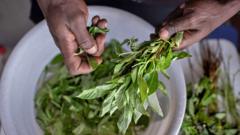In Kenya, a remarkable shift is occurring as indigenous leafy vegetables, often termed "kienyeji," transition from neglected weeds to culinary stars. These local varieties, which include nutrient-rich greens like managu (African nightshade) and mrenda (jute mallow), are now being embraced by consumers eager to enjoy their distinct flavors and health benefits. At Skinners Restaurant near Nairobi, diners increasingly request these local ingredients, despite their higher prices due to limited supply.
The changing attitudes toward kienyeji highlight the growing recognition of their health advantages, driving demand above that for commonly available imported greens such as cabbage and kale. "It's all about its taste, which is better," one patron shared, echoing the sentiments of many who appreciate the unique flavors of traditional crops.
Research from Professor Mary Abukutsa-Onyango underscores this trend, revealing that production of these indigenous greens has doubled over the past decade, with local farmers producing 300,000 tonnes last year. Previously deemed weeds, these vegetables offer superior nutritional value compared to their non-native counterparts. With more antioxidants and vitamins, they are increasingly regarded as essential components of a healthy diet.
In 2021, UNESCO recognized efforts in Kenya to preserve these traditional crops, highlighting the country's initiatives to document local food varieties. The initiative began in 2007 and now encompasses an inventory of 850 indigenous plants, reflecting a commitment to biodiversity and cultural heritage.
As the demand for kienyeji rises, challenges remain. Farmers like Francis Ngiri face legal hurdles when trying to cultivate and market these indigenous crops, as regulations restrict the exchange of uncertified seeds. Despite the risks involved in seed swapping, Ngiri continues to cultivate a remarkable diversity of native plants, demonstrating resilience against the backdrop of soil degradation caused by chemical farming practices.
While sukumawiki remains a staple in Kenya, many are drawn to the organic offerings of farmers dedicated to preserving traditional nutrition. Vendors in local markets report an explosive growth in sales of indigenous greens, courtesy of ongoing media campaigns that celebrate their benefits.
With national gene banks actively working towards aligning agricultural laws with international treaties to protect farmers' rights, the future of Kenyan indigenous vegetables appears promising. As consumers and producers come together, the culinary landscape is evolving, showcasing a renewed appreciation for Kenya's rich horticultural heritage.



















